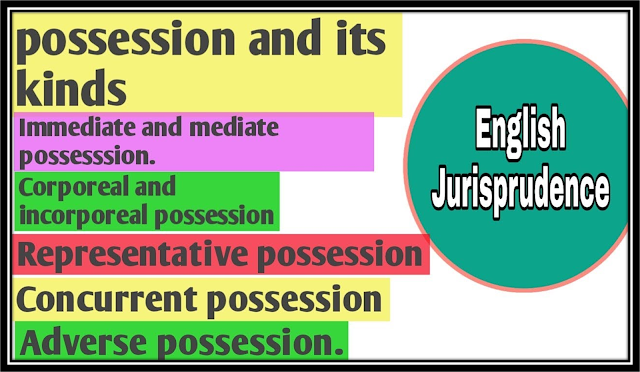Kinds of Possession under English Jurisprudence
The concept of possession is fundamental in English law, particularly in property law. It refers to the control a person exercises over a thing, be it tangible or intangible. Possession serves as a prima facie indicator of ownership, though it is not synonymous with ownership itself. Here, we delve into the various kinds of possession recognized under English jurisprudence:
1. Corporeal vs. Incorporeal Possession:
Corporeal Possession:
This refers to the physical control of a tangible object. Examples include holding a book, occupying a house, or driving a car. To establish corporeal possession, two elements are crucial:
Actual control:
The person must exercise physical control over the object, excluding others.
Animus possidendi (intention to possess):
The person must intend to possess the object for themselves, not on someone else's behalf.
Incorporeal Possession:
This applies to intangible rights or interests. It involves the exercise of control over rights that cannot be physically held, such as copyrights, trademarks, or patents. Here, possession is manifested by acting in a way that demonstrates the right to exploit or enjoy the intangible property.
2. Mediate vs. Immediate Possession:
This distinction is no longer strictly followed in English law, but it's helpful for understanding possession through intermediaries.
Mediate Possession (Indirect Possession):
This occurs when a person possesses an object through another person acting on their behalf. For instance, if you leave your car with a valet, you retain mediate possession while the valet has immediate possession.
Immediate Possession (Direct Possession):
This is the direct physical control of an object by the possessor themselves. Buying a book from a store and holding it is an example of immediate possession.
3. Constructive Possession:
This refers to a situation where a person has the legal right to possess something, even though they may not have immediate physical control. It's essentially a "possession in law" rather than "possession in fact." Examples include:
Owning a car parked at a friend's house.
Having a lease agreement for a property that is currently occupied by the previous tenant.
4. Adverse Possession:
This is a concept where someone acquires legal ownership of property by possessing it for a certain period (usually 12 years for land) without the rightful owner's consent. The possession must be:
Adverse:
The possessor must act like the true owner, excluding the rightful owner.
Continuous:
The possession must be uninterrupted for the prescribed period.
Open: The possession must be obvious and not secretive.
5. De Facto vs. De Jure Possession:
These terms are sometimes used to differentiate between actual physical possession (de facto) and legal possession (de jure). De jure possession often refers to constructive possession, where someone has the legal right to possess but may not have immediate physical control.
Understanding these distinctions is crucial in various legal contexts:
Property disputes:
Determining who has the better right to possess an object is essential in resolving ownership claims.
Trespass:
Possession is a key element in establishing trespass, where someone unlawfully interferes with another's possession of property.
Land law:
Adverse possession plays a significant role in acquiring ownership of land through prolonged possession.
It's important to note that possession is a factual question to be determined based on the specific circumstances of each case.
The concepts outlined above provide a framework for analyzing possession under English law. Consulting with a legal professional is recommended for in-depth guidance on specific situations.

